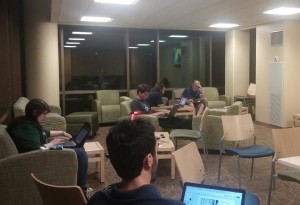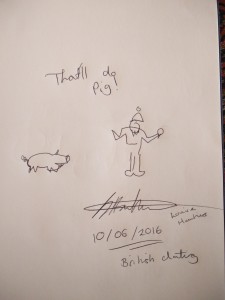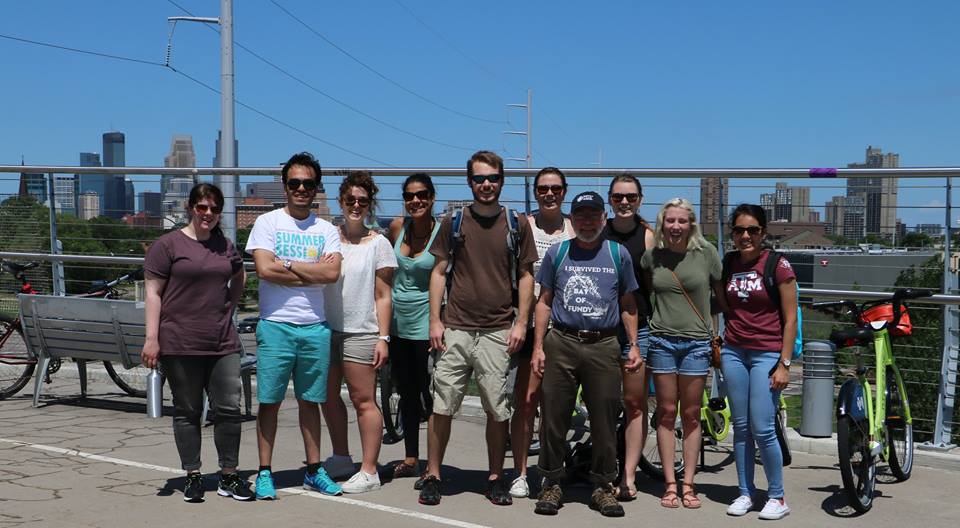
The Summer School participants at the end of School dinner (Photo credit: Mostafa Ahmadzadeh)
So I’m a little late in posting this but it wasn’t too long ago that I attended the Institute of Rock Magnetism’s Summer School. Generally the School is only run every two years but, due to changes to the labs next summer, it was run this year as well as last year… and I’m glad it was. I highly recommend this School to any graduate students working in paleo-, archeo-, rock- and environmental magnetism. It answered a lot of the questions that I’ve had since starting my PhD and it was a fantastic opportunity to get to grips with some amazing magnetic equipment that I’ve not had the opportunity to use before. While the lectures by Bruce Moscowitz, Mike Jackson, Dario Biladrillo, Josh Feinberg and Lennart de Groot (who popped over from San Diego to give a talk on paleointensity) were all fantastic, what I really want to talk about here is the group project that I was a part of; looking at the suitability of Peruvian pottery for studying the Levantine Spike.
For those of you who are unfamiliar with the Levantine Spike, it is thought to be a rapid increase and decrease in field intensity to 3-4 times the background field intensity at around ~1000B.C. The spike was initially observed by Ben-Yosef et al. (2009) in the waste from Iron Age copper production in South Jordan but has since been seen in Israel (Shaar et al., 2011), Turkey (Ertepinar et al., 2012), Texas (Bourne et al., 2016) and probably the Canary Islands (de Groot et al., 2015) and China (Cai et al., 2014).
Since its discovery, there has been a great deal of controversy surrounding this geomagnetic spike. When the original paper was published, it seemed difficult to accept because a) the spike is not evident in the European record, which is the most complete archeomagnetic record available, b) the magnitude and the short duration of the spike (possibly as short as 30 years according to Shaar et al., 2011) could not be reconciled with core flow models and c) the copper waste products that the spike was initially observed in are quite different from the lavas and ceramics that are usually used in paleointensity experiments and so the reliability of the results was questioned. The geomagnetic spike has gained greater acceptance since, as it has been observed across other locations and in materials more conventionally used in palaeointensity experiments. However there are still problems reconciling the size and length of the spike with our models of core flow.
Even using the longest possible estimates for the spike, approximately 400 years (Bourne et al., 2016), the spike is only just resolvable with the maximum possible rates of field intensity change modelled, assuming that the spike is the result of a local flow feature at the outer cores surface (Livermore et al., 2014). These models also suggest that we should see the spike in the nearby Greek and Bulgarian records but this is not the case. Another possibility is that the spike may be a manifestation of columnar convection; this has been suggested based on evidence of paired lobes of relatively rapid geomagnetic variation in the northern and southern hemispheres (the Middle East and Africa) over the last 200 years (Shaar et al., 2015). However, a single column could not explain the expression of the spike at sites as far apart as the Middle East and Texas.
Another reason we are interested in constraining the nature of the Levantine Spike is because of the problems with Radiocarbon dating around this time. This technique works by measuring the amount of Carbon-12 (12C), the most common isotope, and Carbon-14 (14C), the radioactive isotope of Carbon, in organic materials. The 14C is produced in the upper atmosphere and then forms carbon dioxide that is taken up by plants and trees. When they die, the 14C decays and so the amount present in the plants/trees reduces over time. The technique assumes that the amount of 14C produced in the upper atmosphere is a constant, so the starting ratio of 12C to 14C should always be the same and, since the decay rate of 14C is fixed, you should be able to determine the age of the material from the amount of 14C left in the sample. However evidence from independently dated tree rings has shown that between 800-400BC the amount of 14C observed in organic materials doesn’t change during this period, suggesting something was affecting its production in the atmosphere; this period is known as the “Halstatt plateau.” For this time period, we need to rely

The team hard at work on our presentation (Photo credit: Mostafa Ahmadzadeh)
For the group project, we had a set of samples from a Peruvian site, from before, during and after the Levantine Spike, to check for their suitability for paleointensity experiments. Results from these samples could improve the paleointensity curve for this region, which would help with field modelling and archeomagnetic dating. They could also answer the question as to whether the spikes represent columnar convection as they roughly line up with the American site.
To assess their suitability, there are several criteria that the samples need to fulfil; the first of thing is to identify the magnetic minerals in the sample to check that their Curie temperatures are high enough to capture the primary remanence component. For this we used the Magnetic Properties Measurement System (MPMS) to identify the low temperature magnetic mineral transitions (down to 2° Kelvin), which allowed us to use the same samples for hysteresis in the Vibrating Sample Magnetometers (VSM). Both the hysteresis and susceptibility, done on the Kappabridge, were measured to high temperatures to give us the Curie temperatures of the samples and the temperature at which alteration of our remanence carriers was occurring. We also looked at the behaviour of the samples during a Pseudo-Thellier experiment (as it’s much quicker than thermal Thellier experiment); looking at the AF demagnetisation for any overprints and to check that the characteristic component goes to the origin and the ARM directions told us whether the samples were anisotropic or not. In the end, we decided we would recommend at least half of these samples for thermal Thellier experiments and this was our team’s conclusion when we presented our work at the end of the Summer School.

“That’ll do pig”
Finally, the Summer School came to its end and there was just one thing left to do. For anyone who hasn’t visited the IRM, one of the things it is well known for is the ‘pig book.’ This is a right of passage for any Visiting Fellow or Summer School participant who comes to the IRM where they must draw a pig while blindfolded. The original ‘pig book’ belonged to Sir (James) Alfred Ewing, the father of the hysteresis loop, who used to invite his famous guests such as Winston Churchill, Alexander bell and Sir Arthur Conan Doyle, to leave an entry. On this note, I will finish with my entry to the ‘pig, book’; see if you can get the movie reference…
I’d like to thank everyone in my team, “Team World Domination,” who were brilliant to work with; Patrick Arneitz (ZAMG, Vienna), Steve Victor and Michael Woodburn (Yale), Jackie Smale (Minneapolis) and our supreme (or at least team) overlord Josh Feinberg (IRM). I would also like to thank Mike Jackson for arranging the Summer School, all the lecturers, who I’ve already mentioned, and everyone who participated in the Summer School for making a thoroughly magical Summer School, especially my Roommate Courtney Wagner (Utah), who made sure that I had an amazing time.

Photo credit: Mostafa Ahmadzadeh




